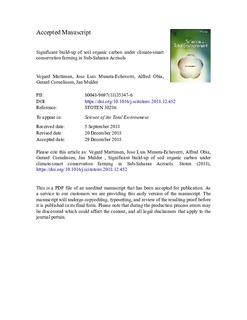| dc.description.abstract | Conservation farming (CF) involving minimumtillage, mulching and crop rotation may offer climate change adaptation and mitigation benefits. However, reported effects of CF, as applied by smallholders, on storage of soil organic carbon (SOC) and soil fertility in Sub-Saharan Africa differ considerably between studies. This is partly due to differences in management practice, soil type and adoption level between individual farmers. Where CF involves planting basins, year-to-year changes in position of basins make SOC stock estimates more uncertain. Here we assess the difference in SOC build-up and soil quality between inside planting basins (receiving inputs of lime and fertilizer; basins opened each year) and outside planting basins (no soil disturbance or inputs other than residues) under hand-hoe tilled CF in an Acrisol at Mkushi, Zambia. Seven years of strict CF husbandry significantly improved soil quality inside planting basins as compared with outside basins. Significant effects were found for SOC concentration (0.74 ± 0.06% vs. 0.57 ± 0.08%), SOC stock (20.1 ± 2.0 vs. 16.4 ± 2.6 t ha−1, 0–20 cm), soil pH (6.3 ± 0.2 vs. 4.95± 0.4) and cation exchange capacity (3.8 ± 0.7 vs. 1.6 ± 0.4 cmolc kg−1). As planting basins only occupy 9.3% of the field, the absolute rate of increase in SOC, compared with outside basins, was 0.05 t C ha−1 yr−1 . This corresponds to an overall relative increase of 2.95‰SOC yr−1 in the upper 20 cm of the soil. Also, hot water extractable carbon (HWEC), a proxy for labile organic matter, and potential nitrification rateswere consistently greater inside than outside basins. The significant increase in quantity and quality of SOC may be due to increased inputs of roots, due to favorable conditions for plant growth through input of fertilizer and lime, along with increased rainwater infiltration in the basins | |
